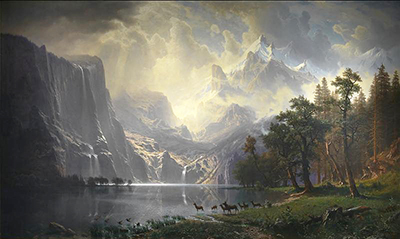This painting Among the Sierra Nevada Mountains California by the German born American artist Albert Bierstadt.
Finished in 1868, it depicts a landscape in the vast Sierra Nevada mountain range which straddles California and Nevada, running almost 400 miles north to south, and which today encompasses various national parks including Yosemite. Bierstadt was associated with the Hudson River School whose members adopted a highly detailed and naturalistic style of landscape painting and often presented scenes suffused with glowing, lambent light. Photographer Ansel Adams also famously captured the Sierra Nevada. Bierstadt's work displays an overall interest in the beauty and majesty of the American west, which at that time was virgin country. His pictures are somewhat idealised depictions of this new found splendor; they were calculated to appeal to the romantic notions his audience had of the West.
The pictures were a critical and popular success. It was in part due to his skill evoking the sublime beauty of this wilderness through his art that calls we made, and legislation eventually put forward, to preserve and sustain these ‘monuments to nature’ as national parks. The composition divides in two at the bright water line in the middle distance above which the mountains soar, and before which the placid landscape unfurls before us, as though we are witness to an unsullied Shangri La, protected and sustained by the impenetrable barrier of the surrounding stone.
Although the painting is horizontally oriented, the cyclopean mountains create an overwhelming sense of vertical movement as the gaze is directed ever up to the seemingly impossible heights which touch the clouds, roiling around the peaks in circular motion. The sense of gigantic proportion is emphasised by the tiny highlights of the waterfalls, which trace faint lines on the sides of the monumental cliffs. The mountains here assume fantastic tooth-like shapes as though they were the ferocious, living wardens of the paradisiacal scene below, through which the deer stalk oblivious to the sublime landscape that they are an indistinguishable part of.




